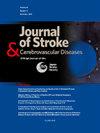Manual assessment of cylinder rearing behavior is more sensitive than automated gait evaluations in young, male mice post-stroke of the forepaw somatosensory cortex
IF 2
4区 医学
Q3 NEUROSCIENCES
Journal of Stroke & Cerebrovascular Diseases
Pub Date : 2025-04-21
DOI:10.1016/j.jstrokecerebrovasdis.2025.108325
引用次数: 0
Abstract
Background
Stroke is a leading cause of long-term adult disability. Behavioral testing with animal stroke models, which offers a way to evaluate the effectiveness of new interventions, currently relies on methods that are time- and labor-intensive. Automated behavioral assessments of locomotion and gait have been proposed as an alternative, but it is currently unknown whether they are sensitive enough to assess behavioral deficits following stroke of the forepaw somatosensory cortex. The purpose of this study was to compare a validated, manually assessed behavioral test, cylinder rearing (a measure of forepaw asymmetry during exploration), with automated behavior tests of locomotion in a rodent photothrombotic stroke model.
Methods
We induced a focal photothrombotic stroke in young (12-16 week old) male mice over the left forepaw somatosensory cortex, conducted behavioral testing at acute (48 h) and sub-acute (4 weeks) time points post-stroke, and then correlated behavior deficits to histological measures.
Results
Three automated behavioral tests were used in comparison to cylinder rearing: CatWalk (spontaneous gait), DigiGait (forced treadmill locomotion), and open field (a measure of general locomotor activity). Cylinder rearing testing showed significant forepaw asymmetry between stroke and sham groups acutely and sub-acutely after stroke. Catwalk, DigiGait, and open field tests showed no significant differences between groups. When correlating behavior to histological measures of stroke, the presence of secondary thalamic injury (STI) was associated with forepaw asymmetry on cylinder rearing.
Conclusions
These findings illustrate the need to find alternative automated behavioral measures for mouse photothrombotic stroke of the forepaw somatosensory cortex.
前爪体感皮层对幼年雄性小鼠脑卒中后圆柱体饲养行为的人工评估比自动步态评估更敏感
中风是导致成人长期残疾的主要原因。动物中风模型的行为测试提供了一种评估新干预措施有效性的方法,但目前依赖于耗时费力的方法。运动和步态的自动行为评估已被提议作为一种替代方法,但目前尚不清楚它们是否足够敏感,以评估前爪体感皮层中风后的行为缺陷。本研究的目的是比较在啮齿动物光血栓性中风模型中,一种有效的、人工评估的行为测试,圆柱体饲养(一种在探索过程中测量前爪不对称的方法)和自动运动行为测试。方法在幼龄雄性小鼠(12-16周龄)左前爪体感觉皮层诱导局灶性光血栓性卒中,在卒中后急性(48 h)和亚急性(4周)时间点进行行为测试,并将行为缺陷与组织学指标进行关联。结果采用了三种自动行为测试:CatWalk(自发步态)、DigiGait(强制跑步机运动)和open field(一般运动活动的测量)。脑卒中组和假手术组在脑卒中急性期和亚急性期前爪不对称显著。t - walk、DigiGait和野外测试显示各组之间没有显著差异。当将行为与中风的组织学测量相关联时,继发性丘脑损伤(STI)的存在与前爪在圆柱体饲养时的不对称有关。结论这些发现表明,有必要为小鼠前爪体感觉皮层光血栓性中风寻找替代的自动行为测量方法。
本文章由计算机程序翻译,如有差异,请以英文原文为准。
求助全文
约1分钟内获得全文
求助全文
来源期刊

Journal of Stroke & Cerebrovascular Diseases
Medicine-Surgery
CiteScore
5.00
自引率
4.00%
发文量
583
审稿时长
62 days
期刊介绍:
The Journal of Stroke & Cerebrovascular Diseases publishes original papers on basic and clinical science related to the fields of stroke and cerebrovascular diseases. The Journal also features review articles, controversies, methods and technical notes, selected case reports and other original articles of special nature. Its editorial mission is to focus on prevention and repair of cerebrovascular disease. Clinical papers emphasize medical and surgical aspects of stroke, clinical trials and design, epidemiology, stroke care delivery systems and outcomes, imaging sciences and rehabilitation of stroke. The Journal will be of special interest to specialists involved in caring for patients with cerebrovascular disease, including neurologists, neurosurgeons and cardiologists.
 求助内容:
求助内容: 应助结果提醒方式:
应助结果提醒方式:


